Nabatean Farms Reconstructed in the Desert
Sidebar to: Understanding the Nabateans040
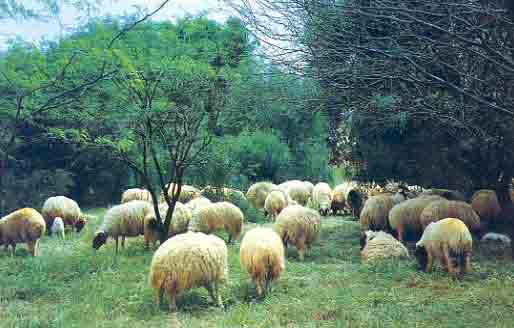
Two thousand years ago, canny Nabatean farmers grew productive crops on farms in the desert. They were able to do this by carefully harnessing the few inches of water that fell for a few hours each year on the barren hillsides, and that then flowed down to the otherwise dry watercourses in the valleys. These farms in the desert were once the breadbasket for tens of thousands of ancient settlers.
In the picture below we see the excellently preserved remains of a Nabatean farm at Shivta (ancient Sobata).
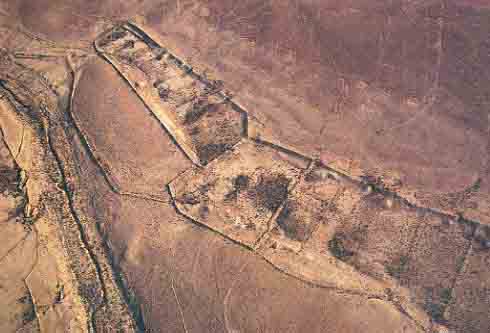
In the late 1950s the Desert Runoff Farms Unit, now a joint project of The Hebrew University of Jerusalem and Ben-Gurion University of the Negev, reconstructed two Nabatean farms, one at Shivta and the other at Avdat.
A team of scientists led by Professor Michael Evenari of Hebrew University recreated the farms on the very sites where the original farms were once planted. The reconstituted Nabatean farm at Shivta (below) retains the same layout and uses the same water distribution system as the original Nabatean farm.
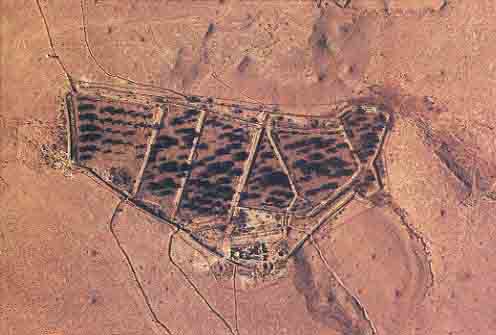
The crops planted at Shivta by the Desert Runoff Farms Unit included olives, pomegranates, almonds, figs, carobs, pistachios, apricots, peaches, plums and grapes. Since the late 1970s, because of lack of funds, there has been no staff at Shivta to manage the reconstructed Nabatean farm. Nevertheless, the crops continue to yield—a dramatic demonstration of the system’s remarkable ability to function with no maintenance whatever.
At Avdat a 20-acre farm was planted not only with 3,000 orchard trees, but also with a wide variety of cereals, vegetables, legumes and pasture plants.
The ancient Nabatean farmers used three basic systems to harness the precious rainfall, so that the mere four or five inches of rain that fell during a few hours a year nevertheless provided year-round sustenance.
The first is the “terraced wadi,” which involves building terraces in a small dry riverbed. A series of stone walls built horizontally across the wadi would create fields behind the walls that would retain a portion of the floodwater and allow excess water to cascade into successive fields below.
This system could not be successfully employed in a large wadi, however. The torrential floods of a large wadi would destroy the terraces. In a large wadi, a second technique, called a “diversion system,” was sometimes employed. In this technique, a dam was built in the wadi, just high enough to raise the water into a channel leading to long terraced fields built on adjacent floodplains.
The most extensively used system, however, was the “conduit channel” system. This system consists of two parts: (1) groups of terraced cultivated fields, usually located in the beds of small tributary wadis, depressions or floodplains; and (2) their “catchment area,” the slopes surrounding the farm 042that supply the fields with runoff water by means of conduit channels that run diagonally along the hillsides. (See drawing.)

From the beginning, the reconstructed Nabatean farms at Shivta and Avdat were designed not only to learn how ancient farmers succeeded and to demonstrate that their success could be repeated today by carefully managing scarce water resources, but also to experiment with new methods and to point the way to modern settlers of arid lands. More than one-third of the earth’s land surface is arid. Over 900 million people live on this land, often in destitute conditions because they do not know how to manage their scarce resources, especially water.
Encouraged by the success of the farms at Shivta and Avdat, in 1933 the Desert Runoff Farms Unit constructed a third farm at Wadi Mashash, near the Negev city of Beer-Sheva where Ben-Gurion University is located. At the Wadi Mashash farm, the goal is to devise additional means of utilizing scarce runoff water—means that can be introduced in other desert areas of the world.
Here scientists are concentrating on the three Fs—food, fodder and firewood, the three most important commodities for the people of the developing world’s arid and semi-arid regions, and now in frighteningly short supply.
Research at Wadi Mashash focuses on rainfall collection systems, crop selection, plant physiology, horticulture, desert hydrology, meteorology and ecology.
Now in use at the Wadi Mashash farm are two additional rainfall-harnessing systems that may or may not have been used in ancient times (if they were used, no evidence of their use has survived): The first utilizes “mictocatchments,” which give each plant its own small water collection slope, the optimal size of which can be determined for different species and for different environments. The walls surrounding the microcatchment can be as low as 6 inches and can be made entirely from earth. (See illustration.)
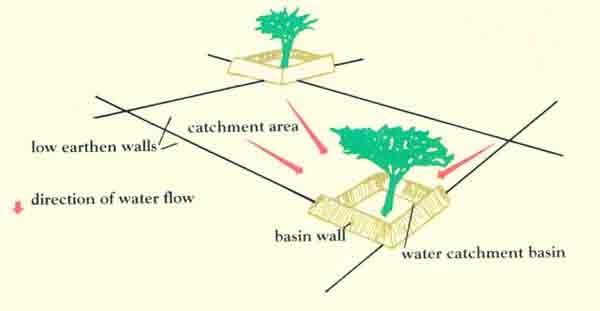
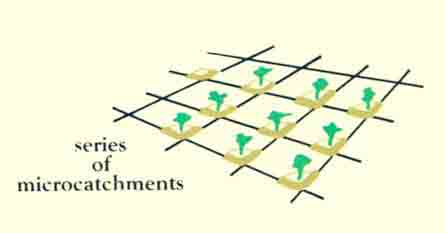
The second method involves the construction of a “liman,” a multi-sided dam built in a floodplain, shallow depression or tributary wadi. A liman traps overland water flow in a large field that then resembles a lake (the word “liman” derives from the Greek word for lake). From there, stone spillways and staircase-like drop structures ease the transfer of water from upper to lower fields. These structures, as well as conduit channels and the walls surrounding the fields, are easy to construct and can be built with local materials and skills.
During the first year at the Wadi Mashash farm, the fodder or pasture plants provided food for 200 Awassi sheep. Soon new sheep varieties, as well as goats, camels, cattle, ostriches and other animals will be introduced.
The ancient Nabatean farms have provided the inspiration for a new generation of desert farms. The desert is again in bloom.
